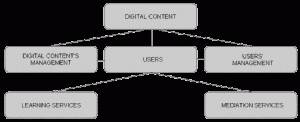Presenting the Architecture of OR E-Courses
Cornel RESTEANU, DOINA BANCIU
I C I Bucharest
(National Institute for R & D in Informatics)
8-10 Averescu Blvd.
011455 Bucharest 1, Romania
resteanu@ici.ro; doina.banciu@ici.ro
Abstract: After a good experience in the e-courses’ design, the authors have arrived at the conclusion that such a course is made from a specific part named course’s digital content and a general part named course’s shell. The first part is represented by the knowledge that must be transferred from teachers to students. The second part, the general one, is represented by the mediator of this transfer. This paper aims at presenting the architecture of an Operation Research e-course by describing the course’s digital content as well as the course’s shell, both generating an ITC product belonging to the software as a service class.
Keywords: Creativity and Personal Development, Livelong Learning, Enhanced Learning Technology, Information and Communication Technology, Internet Computing, Software as a Service.
>Full text
CITE THIS PAPER AS:
Cornel RESTEANU, Doina BANCIU, Presenting the Architecture of OR E-Courses, Studies in Informatics and Control, ISSN 1220-1766, vol. 19 (4), pp. 369-378, 2010.
1. Introduction
In the Creativity and Personal Development (CPD) era, the Lifelong Learning (LLL) concept acquires new meanings with the e-courses development in Enhanced Learning Technology (ELT) using Information and Communication Technology (ICT), mostly Internet Computing (IC) tools. Every highly educated person currently learns in his / her social life. Also, one may notice that the available time for learning decreases with age and socio-professional position.
As a consequence of these facts, the courses made by experts, for integral electronic learning, having the Internet as support, which may be used according to a personal schedule, are nowadays the most appropriate. But such a course is very difficult and expensive to realize. Then the main idea is to approach each domain (like mathematics, physics, chemistry, biology, informatics, engineering, pedagogy, etc.) separately and try to design a standard e-course for each of them.
The project named “Excellency Level Tools for Multi-Attribute Decision Making [1, 2] Field’s Promotion”, belonging to a Romanian research program, aligned to the European program in this domain [3], produced the Multi-Attribute Decision Making (MADM) e-course with a general shell (GS) named “OR e-courses shell” that can present the digital content (DC) (Figure 1) not only for this very course but for every one presenting the same structure of its knowledge thesaurus (KT). KTs that have the same structure belong, in the present case, to the Operations Research (OR) domain, containing mathematical programming, graph theory, transport problems, stochastic processes, queuing theory, game theory, decision analysis etc.

 Figure 1. From regular OR learning to continuous individual learning
Figure 1. From regular OR learning to continuous individual learning
The e-course, named ‘Do learn by yourself MADM’, will be presented following the general block-scheme used in design (see Figure 2).
The central role is attributed to the users: administrators, professors, tutors as e-course’s creators, and students / visitors as e-course’s beneficiaries.
 Figure 2. Block scheme for the ‘Do learn by yourself MADM‘ e-course
Figure 2. Block scheme for the ‘Do learn by yourself MADM‘ e-course
The users have a management module which works on a data base. It provides users’ lists and lists linked to students’ learning rhythm, exams’ situations, interactivity with the e-course, graduation diploma etc. The digital content has a complex management module which works on a knowledge base. Learning items, as lessons, tests, problems/case studies, most frequent asked questions, bibliography, and additional items, as auto-presentation, users’ guide and sensitive help are provided through these management modules.
The services offered to the students are learning services and mediation services that assure the interface with a part of the Internet environment dealing with this electronic course [4, 5, 6].
REFERENCES
- Hwang, C-L., K. Yoon, Multiple Attribute Decision Making. Springer-Verlag, Berlin-Heidelberg, New York, 1981.
- Hwang, C-L., M. J Lin, Group Decision Making under Multiple Criteria, Springer- Verlag Berlin-Heidelberg, New York. 1997.
- http://europa.eu.int/comm/education/policies/2010/ et_2010_en.html.
- Rumble, G., Reinventing Distance Education, 1971-2001. Intl. Journal of Lifelong Education, 20, 2001, pp. 31-43.
- Thorsteinsson, G., T. Page, A. Niculescu, A Blended Learning Approach to Enhancing Innovation, Studies in Informatics and Control, vol. 17(3), 2008, pp. 297-304.
- Thorsteinsson, G., T. Page, A. Niculescu, Adoption of ICT in Supporting Ideation Skills in Conventional Classroom Settings, Studies in Informatics and Control, vol. 19(3), 2010, pp. 309-318.
- Resteanu, C., F. G. Filip, C. Ionescu, M. Somodi, On Optimal Choice Problem Solving, Proc. SMC’96 Congress (Beijing, Oct. 14-17). A.P. Sage, W. Zheng (Eds.), IEEE Publising House, Piscataway, 1996, pp. 1864-1869.
- Giarratano, J. C., G. D. Riley, Expert Systems: Principles and Programming – 3rd ed. PWS Publishing Company, Boston, 1999.
- http://www.nottingham.ac.uk/teaching/resources/methods/elearning/mathemat519/
- http://www.wordreference.com/definition/pervasive
- Banciu, D., Digital Libraries from Concept to Practice, Contributions to ICT Progress, Technical Publishing House, Bucharest, 2007, pp. 77-93.
- Banciu, D., Albu, C., The Role of the e-Book in Learning Process, Proc. 2nd Balkan Reg. Conf. on Eng. Edu., (Sept. 16-19, 2003 Sibiu, Romania) pp: 183-184.
- Sebestyen, G., D. Banciu, T. Balint et al., Digital Content Management on GRID Structures, Proc. Conf. Information: IEEE 3rd Intl. Conf. on Intelligent Computer Comm. and Processing. (Sept. 06-08, 2007 Cluj-Napoca, Romania) pp 259-262.
 Studies in Informatics and Control – ICI Bucharest
Studies in Informatics and Control – ICI Bucharest